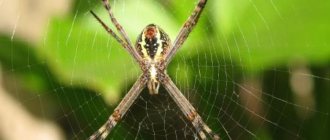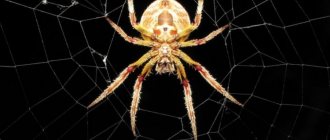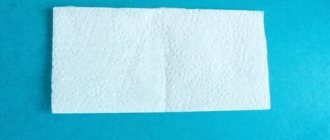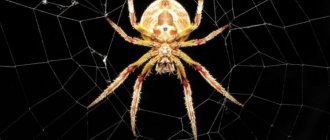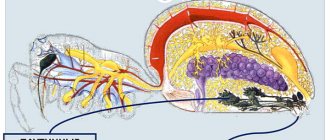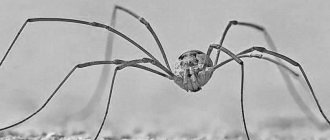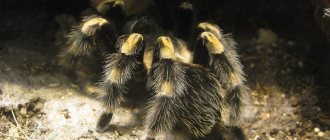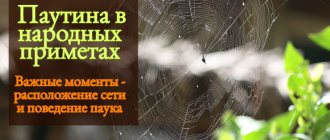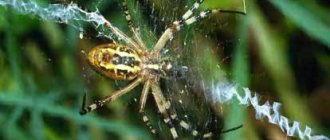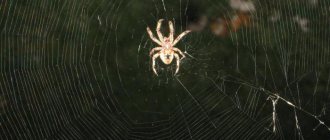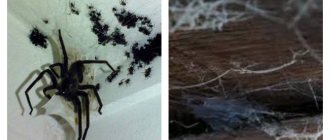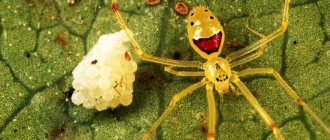What is a web
A spider in its web.
The web itself is the secret of the arachnoid glands that freeze in the air. It is produced in special arachnoid warts, thin outgrowths on the edge of the abdomen.
The spider web contains the protein fibroin, which forms fibers and makes them strong and elastic. For connection and attachment, the same matter is used, which is immersed in a special adhesive gel secreted by other glands. They also produce fiber from the anterolateral warts, which is a slightly watery material that covers the threads themselves.
How does a spider make a web?
Creating a web.
The process itself is very interesting. Production goes like this:
- The spider presses the web warts to the substrate.
- The secret sticks to him.
- The spider uses its hind legs to pull out the viscous mixture.
- As the spider moves forward, it draws out the secretion and it freezes.
- The animal walks along the thread several times, thereby strengthening it.
Links
Animals Wool · (Mohair · Cashmere) · Silk · Catgut · Spider web · Pashmina Mineral Asbestos Chemical Synthetic Acrylic · Aramid · Arcelon · Nylon · Lavsan · Microfiber · Polyurethane fibers · Kevlar · Prolene · Monocryl Inorganic Fiberglass · Carbon
Usage and Functions
Spider web fiber is very strong, comparable to the density of nylon. According to some opinions, this is because the spider creates it while hanging on the same fiber.
It has interesting features:
- Tension. Even though the threads are compressed or stretched, they return to their usual place.
- Articulation. An object in a web can be rotated in one direction, but it will not twist or get tangled.
It is believed that the main function of the web is to catch prey. This is true, but it has a number of other important functions.
For food
Spider food caught in the net is immobilized there. And they often wrap the prey itself in a web.
For reproduction
Males may begin the act of courting a female by tugging at her web, thus attracting her attention. Some species leave seminal fluid on the web to fertilize the female.
For posterity
The eggs also develop in a cocoon of spider webs. Young animals are raised there for some time.
For life
Water spiders make cocoons underwater, leaving air in them for breathing. Those who build holes weave it around the inside of the home.
For guard
Some species weave leaves into the web, which act as puppets. Spiders move them when predators approach in order to deceive them.
Types of web
Depending on the type of spider, the shape of the finished web structure differs. This can be said to be a distinctive feature.
Usually there are 3-4 load-bearing threads, which are the basis of the structure and are attached to the base with connecting disks. Radial ones converge towards the center, and spiral ones create shape.
It’s curious, but the spider itself is not attached to its web and does not stick. It only touches the nets with the tips of its feet, and there is a special lubricant on them.
Round form
Round web.
This beautiful lightweight lace is a deadly weapon. The spider first makes a frame, then places radial fibers towards the center, and at the end the spiral threads are laid.
The prey falls into such a trap, and the hunter senses movement and gets out of the ambush. If a hole appears in the web, the spider completely weaves a new one.
Strong web
This is a design of a round or similar shape with a large diameter. A net with a large number of meshes is prepared to catch large prey. There is a hammock - a structure in which spiders settle and wait for their prey. It is flat, located like a horizontal mattress, from which vertical threads extend along the edges for fastening.
Variety of web.
LiveInternetLiveInternet
Web in the life of spiders
V.E. Efimik
This essay talks about the ecology of spiders and the role of the web in their life.
Spiders live in various biotopes. On land they are found from deserts to tundras. There are many semi-aquatic forms, but there is also a truly aquatic one - the silver spider
(Argyroneta aquatica).
Despite the wide variety of life forms, the spider has always remained a spider. He always, in all the main life manifestations that support the existence of the species (obtaining food, reproduction, dispersal and surviving unfavorable conditions), used the web. From it he makes a shelter and a catching device, weaves an egg cocoon and a wintering sac, with its help the spiders undergo a complex mating procedure, and the young are carried away by the wind on it. Even the name of the class of arachnids, in which spiders are included in the rank of order, was given due to the ability of spiders to weave webs. A Greek myth
about a young girl named Arachne tells of her being transformed into a spider for daring to compete with the goddess in the art of weaving.
So she was destined to weave webs all her life, and arachnids began to be called in her honor - arachnids
.
The evolutionary significance of webs for spiders
The web was decisive
significance in the evolution of spiders. As already noted, spiders use it all the time in one way or another. We can say that they interact with the outside world through their web-like devices. In this regard, spiders, adapting to new conditions, first of all changed their web adaptations, changing little themselves, which means they retained the general type of organization. Indeed, spiders, despite their great species diversity, maintain unity in their biology, type of nutrition, and individual development. In this regard, it is instructive to compare them with ticks. The variety of feeding methods and lifestyles of ticks has led to significant changes in their organization. The differences between the biological groups of mites are so great that among them taxonomists distinguish three independent orders, different in structure and way of life.
The great importance of the web
in the life and evolution of spiders is explained by the peculiarities of the organization of the spiders themselves.
Their arachnoid apparatus formed in a convenient place - on the abdomen. The non-sclerotized, stretchable abdomen easily accommodates voluminous arachnoid glands, which provide an abundance of webs. The function of removing the secretions of the glands is performed by the abdominal limbs, which have turned into arachnoid warts and, which is very important, have retained mobility. And most importantly, the abdomen has become mobile, since it is connected to the cephalothorax by a thin stalk. Plus,
the seven-segmented limbs of the cephalothorax provide high mobility to the entire body.
The result is a fairly voluminous and extremely mobile unit for the production of silk and spinning of various web structures. Movable arachnoid warts
ensure targeted penetration of silk secretions. It is also important to have special carding and spinning tools: comb claws and rows of bristles on the legs for combing cobwebs. To be fair, it should be noted that webs are used not only by spiders, but also by their closest relatives - false scorpions and spider mites. But the location of the arachnoid glands in the front pair of limbs - the chelicerae - did not allow them to achieve such development as in spiders. The caterpillars of some butterflies also secrete a lot of silk, but their silk glands are located in the front and, importantly, are not preserved in adult insects, which means that the use of silk is limited to cocoon weaving. In spiders that develop without metamorphosis, the arachnoid glands are preserved at all stages of life.
Let's summarize.
Although the ability to produce silk is not exclusive to spiders, these peculiar arthropods have perfected the production of silk and web structures to the point that web-building has become their distinguishing feature.
Hypotheses about the origin of spider silk
The question of the origin of silk in spiders, which has long worried arachnologists, remains relevant today. There is no direct evidence of the origin of the web, where it came from. After all, the web is not preserved in a fossil state. Therefore, scientists can only offer hypotheses
the origin of spider silk, based on the study of the anatomy of spiders and the features of their web activity.
The most probable is the hypothesis of G. McCook, in which an American researcher of spider behavior suggested that primitive spiders, like modern centipedes, left trace marks during movement with excretory secretions of special glands located at the base of their legs. According to McCook, the excretory function of these glands over time completely transferred to the anterior ones (in living spiders, at the base of the first pair or the first and third pairs of legs there are excretory coxal glands), some were reduced, and the remaining ones on the abdomen retained the ability to mark marks. The trace secretions were replaced by elastic protein silk, and some of the abdominal appendages were transformed into arachnoid warts. And today, most spiders constantly pull the web thread along with them while moving, and the threads of females can be a good guide for males in their search for a sexual partner. confirmed
by the proven origin of arachnoid warts from the rudiments of the abdominal limbs based on the study of individual development.
Other hypotheses do not have widespread scientific support. For example, R. Pocock
and
W.
Bristowe suggested that the web was released from the mouth opening to lubricate the laying of eggs.
The Dutchman Arthur Decae
proposed a “marine” hypothesis, according to which the spiders’ webs appeared even before they became terrestrial. In the aquatic environment, A. Dike believes, the web could protect burrows made in sea soil from destruction or filling with sediment.
Chemical composition. Physical properties of silk
The secretion of the arachnoid glands is a viscous, partly rubber-like mass that quickly hardens when in contact with air. In terms of its chemical composition, the web is close to the silk of silkworm caterpillars, differing in its lower content of sericin, an adhesive substance that is soluble in water. The basis of spider and caterpillar silk
is a water-insoluble fibroin consisting of a complex complex of albumin, alpha-alanine and glutamic acid.
In terms of physical properties, spider threads differ from caterpillar and artificial silk in being more durable. Thus, the breaking force, expressed in kg per 1 mm2, for spiders ranges from 40 to 261, and for caterpillar and artificial silk, respectively, does not exceed 43 and 20. The web has antibiotic
properties, especially the one that is used to make the cocoon, protecting the eggs from the harmful effects of bacteria and molds. If necessary, the spider can secrete sticky or dry thread of a certain thickness and color. Dry (non-sticky) thread is used to make a cocoon and to build vertical wheel-shaped nets in orb-weaving spiders. The last of these threads tension the network frame and its internal radii. The adhesive thread is based on double silk fibers covered with a layer of sticky mucous secretion. Soon after the formation of these threads, the sticky layer fragments due to surface tension, forming tiny droplets (like beads on a string). This sticky coating is short-lived and loses its properties as it dries. Therefore, most spiders that weave webs from such silk must periodically renew the sticky thread.
A very special case is "yarn" or "lace"
cribellate spiders (spiders that have a small sclerite in front of the arachnoid warts - a cribellate plate with thin holes from which special silk is secreted). Two or four threads are surrounded by a wide mucous muff. Another thread twisted into numerous loops is immersed in it. Thanks to this structure, insects not only stick to the web, but also get entangled in it with their bristles and hairs, and its sticky mucus does not dry out for a long time.
Web adaptations associated with reproduction and dispersal
As already noted, webs are used by spiders during their breeding season. It is thanks to the web that this process has become unique in its complexity and originality among similar phenomena characteristic of arthropods. Spiders are characterized by internal fertilization, which is preceded by mating. But the copulatory organs of males (bulbs) are not located on the abdomen, but on the forelimbs - pedipalps or claws (not to be confused with four pairs of walking legs). To transfer sperm from the underside of the abdomen, where the male genital opening is located, to the spermophore of the bulbs, a so-called sperm mesh is used. Often this is a small delicate mesh of a triangular or quadrangular shape, stretched horizontally in the form of a hammock. Pressing his abdomen against the mesh, the male leaves a drop of seminal fluid on it and immerses the ends of the pedipalps into it. Sperm fills the narrow channel of the sperm storage chamber due to its capillarity. When searching for a female, the male spider is guided mainly by smell
. But, encountering a cobweb thread on his way, he unmistakably finds the female who left her. Having discovered a sexually mature female, the male begins to court her, and this manifests itself in different spiders in different ways. We will describe only those cases in which the web is used. The males of some tentworts (family Theridiidae) weave small mating nets next to the female's nets, to which she is lured by rhythmic movements of the legs. Instead of mating nets, male cross spiders (genus Araneus) pull a horizontal web thread onto the radial threads of the female web and, having become more comfortable, begin to drum on it with their feet. It should be noted that the movements of the legs made by the male are not random, like those of a prey struggling in the nets, but rather rhythmic and consist of repeating melodies, which represent a specific signal that indicates the presence of a sexually mature male of the same species. If the female is ready to mate, then sooner or later she leaves her shelter or the center of the network and descends to the place where the thread-string is attached, without showing aggression towards the male musician.
Fertilized eggs are laid in a heap in a cocoon
, made by a female from one or several layers of web. The cocoon itself is a shell that directly surrounds the eggs, and usually consists of a main and covering plate connected by the edges. This structure of the cocoon is explained by the method of its manufacture. The female first makes a main plate from spider silk (analogous to the spermatic mesh of males) and lays eggs on it, and then braids them on top with a spider's covering plate. The wall of the cocoon is usually made of tight-fitting straight threads and is often impregnated with a solidified secretion secreted through the mouth. In this case, the cocoon shell is dense and resembles parchment. In other cases, the web tissue for the cocoon is loose and fluffy, like cotton wool. The shapes of cocoons are different: disc-shaped, spherical, pear-shaped.
The hatched juveniles of the same clutch stay together for some time, then the spiders disperse. In some species, dispersal occurs on spider webs through the air. Young spiders climb onto elevated objects and, raising their abdomen, release a web thread. If the thread is of sufficient length, carried away by air currents, the spider becomes unhooked and carried away on it. In some species, especially small ones, they settle
and adult forms.
Spiders can be lifted by air currents to significant heights (up to 2-3 km)
and transported over long distances. There are known cases of small spiders flying en masse onto ships located hundreds of kilometers from the coast.
Web devices and structures related to protection
All spiders can be divided into two groups: tenet spiders, which make trapping webs (teneta), and non-netet forms, which do not use web devices during hunting. Even representatives of the second group of spiders use webs during periods of life when they are most defenseless. During resting, molting and wintering, they weave web bags or tire panels. Anyone who has ever tried to catch a spider is familiar with the characteristic feature of spiders to use a safety thread in moments of danger. Web spiders
when dangerously approaching them, they fall down, leaving behind a cobweb thread, along which, like a rope, they climb back to the net. When returning along the safety thread, the spider does not forget to reel it in and eat it. Free-living spiders also use safety thread. For example, jumping spiders attach such a thread to the substrate before suddenly jumping on prey [4]. The South Russian tarantula (Allohogna singoriensis) uses similar insurance. When a spider leaves the hole in a calm environment, it pulls an invisible web thread along which it returns. If such a thread is broken, the tarantula is unable to find its hole and sets off to travel in search of a new shelter [3]. Some species of jumpers of the genus Evarcha spend the night on such safety threads. They attach one end to a blade of grass, and hang from the other. In this way, these spiders protect themselves from unexpected encounters with nocturnal predators.
Tarantula
, like many other burrow-digging spiders, uses webs to line the walls of its shelter.
The silk lining prevents the walls from falling off. A hole dug for permanent housing or even just for a day's rest is, of course, better than a temporary shelter under stones or fallen trunks, but it cannot protect against sneaky enemies like road wasps. Therefore, it is no coincidence that many species have all kinds of cobweb superstructures above the entrance to the burrow. These are vertical two-centimeter tubes, and long above-ground horizontal tubes, and funnels, and, finally, movable lid doors that close the entrance. In some tarantula spiders,
the operculum is thickened due to soil particles and plugs the burrow like a plug. Usually the spider sits in the hole during the day, holding the lid with chelicerae. From the outside, the cap is masked by soil particles and plant debris and is indistinguishable from the surrounding background.
Typical theridiid web
and
araneid orb weavers,
in addition to the trapping net, often weave a small lair, most often in the form of a cap.
It is made from pure silk or contains an admixture of plant residues or other foreign particles that are organically included in the structure. These lairs are necessarily connected to the trapping net
and are sometimes placed in its center, but are often located outside it.
Some araneids use living leaves of trees and shrubs to make a lair, skillfully rolling them into a cone and fastening them with cobwebs. Particularly noteworthy is the web structure of the only water spider - the silver spider
(Argyroneta aquatica), which it constructs under water. This species in Russia is widespread in standing and slowly flowing waters rich in vegetation. Bringing air from the surface at the end of the abdomen in the form of bubbles, it builds an air bell underwater among the vegetation. The air in the bell is held in place by a thick web of cobwebs, from which the catching threads extend.
Web-like adaptations associated with obtaining food
All spiders are predators
, but unlike predatory insects they do not have good vision.
Their myopia often determines the use of such a hunting strategy as lying in wait, waiting for prey. Within this strategy, three tactics of spider behavior can be distinguished. The first is an ambush attack on the victim. The second is sneaking a short distance for the decisive throw. The first two tactics are followed by the majority of non-web spiders: side-walking spiders (families Thomisidae and Philodromidae), jumping spiders (family Salticidae), wolf spiders (family Lycosidae). But spiders would not be spiders if they did not use webs during their hunt.
Spider webs, and more often complex web structures, have proven to be an excellent tactical step in applying the waiting strategy. This allowed the spiders not only to increase their catching area, but also to expand their feeding range. Spider snares catch prey larger than the hunters themselves, including well-armed, stinging, and flying insects.
The options for using spider threads to capture victims are extremely diverse.
- from signal threads, peculiar lassos to skillfully woven
snares
.
The use of webs for hunting purposes is typical not only for spiders that weave hunting webs, but also for webless forms. Bird-eating spiders, for example, lift the caught prey high, holding it in the chelicerae, and under it they weave a small bedding web, to which they attach their prey. Spiders that live in burrows and tubes stretch signal threads from the mouth of the lair. Touching
them lets spiders know that prey is approaching.
Not all so-called shady people
they weave real networks.
The small spider Dipoena tristis, as if on a rope, hangs on its web thread above the ground in places where ants are common, and thus lies in wait for them. Another interesting example is provided by tropical African spiders of the genus Cladomelea. When starting to catch prey, the spider releases a thread up to 2 cm long with a drop of sticky secretion at the end. Then, with the help of the third pair of legs, he begins to quickly swing this thread, spinning it around himself. If an insect touches this droplet, it sticks to it. Then the spider pulls the victim towards itself and sucks it out. This method of extraction is possible, of course, only in places where insects accumulate. The closest relative of Cladomelea, American tropical spiders of the genus Glyptocranium, also hunt with the help of an adhesive thread, but hold it in the outstretched front leg. Approaching the insect cautiously, these spiders suddenly throw their “lassos” and pull the stuck prey towards them. Cribellate spiders
of the genus Miagrammopes from South Africa stretch a single horizontal thread between the branches, ranging from 90 cm to 3.6 m in length. Its middle part is additionally covered with cribellate threads. The spider sits on one end of the thread without releasing it. When the insect touches the thread, it instantly weakens it, which helps entangle the prey.
Spiders are able to manipulate not only individual threads, but also small networks
.
The tropical spider Dinopis spinosa
from Central and South America holds its web on the tips of its legs.
When an insect runs or flies past, the spider quickly throws a net over it and pulls it towards itself. But what spiders are famous for is that they can create complex trapping structures from their webs.
Spider webs come in a wide variety of shapes.
Funnel web spiders (family Agelenidae) build their webs on the ground or grass. From the silk tube, which is located right there in the thickness of the grass, a funnel-shaped expansion extends, continuing into a horizontal awning or panel. Sitting at the entrance to the spider's shelter tube, the spider lies in wait for insects crawling onto the trapping net. Theridiid web spiders, which include the black widow, widely known for its poisonousness, build irregular webs, which are a chaotic network of inclined threads. The theridiid Steatoda castanea
constructs a wide-loop net under stones, the vertical sticky threads of which form a thick palisade near the ground - a trap that is almost insurmountable for crawling insects.
Canopy spiders from the family Linyphiidae make horizontal webs-awnings, from which supporting threads extend up and down. Flying insects stumble upon vertical threads and fall onto the awning, where the owner watches for them. The dome-shaped nets of long-legged spiders are constructed according to the same principle. The most advanced
type of nets are the wheel-shaped webs of orb-weaving spiders (families Araneidae, Tetragnathidae and Uloboridae). Such networks consist of a support frame stretched between branches or other objects, radii connecting the frame to the central plexus, and a sticky spiral superimposed on the radii of the catcher. Wheel-shaped networks can be vertical, which is more common, and horizontal.
Hypotheses and theories of network evolution
Arachnologists became interested in the history of the development of web trapping structures back in the 19th century. In 1895, the Englishman R. Pocock
(R. Pocock) was the first to propose a diagram describing the evolution of spider webs. His work was continued by many researchers. The most famous study of the evolution of spider webs belongs to the British arachnologist W. Bristowe, a proponent of the linear evolutionary scheme.
W. Bristow
believed that the evolution of tenet followed two independent paths.
He divided all spiders into those who laid egg cocoons in secluded places on the ground, weaving a bag-like shelter for this, and into those who did not make shelters, but hung the cocoon openly among plants. In the first group of spiders, trapping webs could have evolved in the following way. A bag-like shelter, located under some object, could move into an earthen hole, serving as the lining of its walls. Some spiders began to pull radially diverging threads from the edge of such an earthen web tube. Such cobwebs, found in the burrows of primitive arthroplasty spiders
(family Liphistidae), play the role of signal threads that warn of the approach of prey or an enemy, and sometimes make it easier to find their shelter.
Further development followed the path of expanding the mouth of the tube in the form of a funnel. The latter easily turns into a net-panel - a wide, somewhat loose silk bedding that precedes the entrance to the tubular shelter. Another direction of development of the tenet is associated with a group of spiders that hunt among plants
.
They hung their cocoon from branches and leaves and guarded it by hanging next to it on a horizontal thread. The threads supporting the cocoon warned of the approach of prey or an enemy. Gradually, by adding new threads around the cocoon, a simple random network was created. Theridiid spiders have such irregular nets. The next stage of development is probably represented by the roof- and dome-shaped networks of canopy spiders
(family Linyphiidae), long-legged spiders (family Pholcidae), etc. The wheel-shaped networks of orb-weaving spiders also originated from the web with a cocoon in the middle.
Later, in the 90s of the 20th century, American researcher William Sher
(W. Sher) proposed a nonlinear scheme for the evolution of tenets.
He attributes his approach to the convergent evolution of distinct types of networks. In particular, the web-panel, in his opinion, could have appeared in two independent ways: from radial threads extending from the mouth of the burrow, and also by creating cobweb superstructures and gradually stretching them into horizontal panels. The wheel-shaped network of orb weavers could have formed in several ways. V. Sher considers the most preferable directions leading from dome-shaped tent nets or horizontal circular cribellate nets.
Another significant difference between V. Sher’s nonlinear scheme is that, according to its author, the snares constructed by spiders in vegetation originated from ground-based trapping networks such as the net-panels of funnel-web spiders (family Agelenidae).
Arachnologists
still do not have
a common view on the history of the formation of spider webs And this is not accidental; the lack of
paleontological facts forces us to look for indirect evidence of certain constructions. Further study of this issue and new evidence will dot the i’s and make our knowledge about the evolution of arachnoid networks and the network-building activities of spiders clearer.
Series of messages “World of Insects”:
Part 1 - Spider - cross Part 2 - Why do spiders weave webs? Part 3 - How does a spider weave its web? Part 4 - The web in the life of spiders. Part 5 - The web and the construction of snares. Signs, legends, bleeding, asthma, warts... Part 6 - Which spiders are poisonous? ... Part 11 - Bedtime movie - the Battle of Borodino. (selection of electronic films both day and night from 2 to 52 for free) search on google Part 12 - New electric cheeks, do we need them??? Part 13 - Giant Lumberjack Titan Beetle
